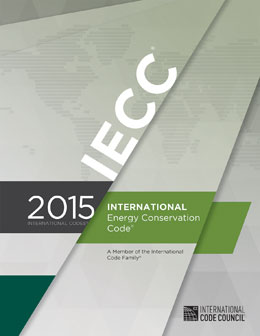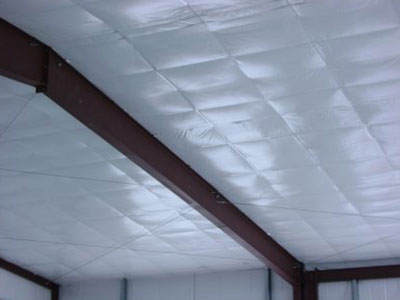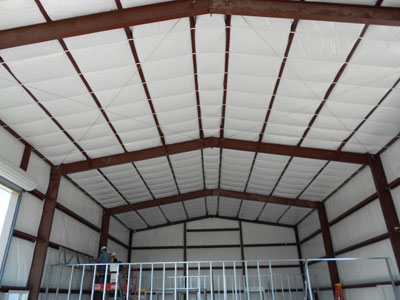Metal Building Envelope Changes You Need to Know

International Energy Conservation Code®
Let’s kick off 2016 with a clear code direction. If you’re not familiar with the new IECC code or the latest ASHRAE update, keep reading to find out how these commercial energy code changes may affect you this year.
First Thing’s First: The Next Code Cycle
The next commercial energy code cycle for most states
will be the IECC 2015 code and ASHRAE 90.1 2013 alternative path. The exact timing of implementation depends on each state. Remember that each state is in a code cycle, which lasts two to three years. So, theoretically, your state could switch in the next few months or in a few years. Check the status of your state energy code here.

An Overview: IECC 2015 and ASHRAE 90.1 2013
Note that I’m basing the upcoming changes on comparisons of the current IECC 2012 code and the ASHRAE 90.1 2010 Standard. If your state’s current code is based on the older IECC 2009 and ASHRAE 90.1 2007 Standard, you’ll see more significant envelope changes. Many states currently at the IECC 2009 code are bypassing IECC 2012 altogether and adopting IECC 2015. This is a huge jump, and many metal building contractors will feel the pressure. If you haven’t used Liner Systems (Ls) or Filled Cavity/Long Tab Systems in the past, you will need to start using them. Both options fulfill the metal building insulation requirements; it’s just a matter of preference. My next post will be all about the key differences between the two systems, so be sure to subscribe to my email list (below) to get that update.

OptiLiner® Liner System

Long Tab with Banding System
The choices are the same for the rest of the envelope. The building designer will have to make the decision to pursue either IECC 2015 or ASHRAE 90.1 2013. Once that decision is made, the entire building envelope, including mechanicals and lighting, must follow the same path.
Changes in Envelope Performance
There are some major changes to the envelope performance. In previous versions of the IECC code and ASHRAE Standards, it was easier to obtain lower insulation values in the roof and walls of metal buildings. The IECC 2015 and ASHRAE 90.1 2013 have the most stringent envelope requirements based on “Conditioned Space” and “ Non-Residential Space”. The only option that allows minimal insulation is Semi-Heated Space within ASHRAE 90.1 2013. Remember that:
Conditioned Space: Space that will be heated above 3.4btu’s/hr/ft2 and/or cooled (per IECC 2015).
Non-Residential Space: Spaces heated or cooled above semi-heated requirement (per ASHRAE 90.1 2013).
Semi-Heated Space: Space heated above 3.4btu’s/hr/ft2 and below 5 in climate zones (CL) 1 and 2, below 10 in CL 3, below 15 in CL 4 and 5, below 20 in CL 6 and 7 and below 25 in CL 8 (per ASHARE 90.1 2013)
Table 3.2, which is used to determine semi-heated space, has not changed with the latest code updates.
|
TABLE 3.2 Heated Space Criteria |
|
|
Heating Output, Btu / h * ft2 |
Climate Zone |
| 5 | 1 and 2 |
| 10 | 3 |
| 15 | 4 and 5 |
| 20 | 6 and 7 |
| 25 | 8 |
If Semi-Heated is not allowed based on the heating system output, then each climate zone has major insulation requirement increases under the non-residential space. This is based on the ASHRAE 90.1 2013 Standard; the IECC 2015 code has, for the most part, the same values. For example, using ASHRAE 90.1 2013, climate zone 5a requires a roof U-value of .037 and a wall U-value of .050. In order to obtain these U-values, a metal building would require either a Liner System or a Filled Cavity/Long Tab System for the roof and a Liner System or Filled Cavity/Long Tab System for the walls.
An Important Update: Air Barrier Requirements
The next big change for the metal building envelope is the air barrier requirement. Under IECC 2015 and ASHRAE 90.1 2013, it’s still the same choice. The designer decides to follow one of three paths: (1) Materials, (2) Assembly, or (3) Whole building. Materials are just that: Any material tested under ASTM E 2178. Assembly consists of a combination of envelope materials built and tested under ASTM E 2157, 1677 or 283. Whole building testing requires ASTM E 779. If this option is used, and the building fails, it must be brought in compliance with the leakage rate allowed, which means you can’t opt out of this option once it’s chosen by the designer. ASHRAE 90.1 2013 does allow a lesser leakage rate if repairs are made.
Although all of the above is required, there are some mandatory requirements related to the air barrier beyond just the paths a designer can opt to take. Buildings are now required to have an air barrier, and it must be located within the building’s thermal envelope. It can be placed on the interior side, exterior side, somewhere within assemblies composing the envelope, or any combination thereof. In IECC 2015 this can be found in section C 402.5.1 and C 402.5.1.1. Exceptions include unheated buildings. In ASHRAE 90.1 2013 this can be found in sections 5.4.3, 5.4.3.1.1 and 5.4.3.1.2. Exceptions include semi-heated buildings in climate zones 1-6.
It is also mandatory to identify the air barrier and for it be continuous across joints and assemblies. Joints and seams must be sealed and securely installed. Penetrations and joints and seals associated with penetrations must be sealed in a manner compatible with construction material and location. I’ll talk more about the importance of air barriers in an upcoming post.
In closing, the code cycle changes that are either here or coming soon to your state are, without a doubt, challenging to say the least. If you have questions about these code updates, call 888-2-INSUL-8. Our Therm-All reps throughout the country are ready for your questions.
Check back for my next post in May, when I’ll cover Liner Systems, Filled Cavity/Long Tab Systems, and air barrier systems.
Want to make sure you don’t miss out on the latest energy code updates?
Subscribe to our energy code newsletter to get blog posts sent directly to your inbox.
MORE BLOGS
COMcheck™: A Live Demo with Bill “The Code Man” Beals
Join Bill “The Code Man” Beals Thursday, October 26th at 2:15 p.m. ET for a free COMcheck™ demonstration. Participants will earn 1 AIA LU/HSW and/or a certificate of completion.
Mid-Year Energy Code Update
I’ve been on the move and traveling the country, giving energy code presentations and attending industry meetings. In this mid-year energy code update, I’m sharing the trends I’ve observed from state to state, with a focus on the challenges and opportunities the IECC 2021/ASHRAE 90.1-2019 energy code cycle poses for metal building contractors, erectors, and designers.
Commercial Energy Codes & MBI: What to Know In 2023
Happy 2023, folks. We’re kicking off the new year with something a little different: A video summary of the current energy code landscape, plus what you need to know as we move into 2023. I also cover the metal building insulation systems that meet the most...
This Just In: Several States Adopt New Commercial Energy Codes
It’s officially the start of fall, folks, and you know what that means: A quick commercial energy code wrap-up. Here’s a short-and-sweet update on what’s been happening around the country. Also, are you attending METALCON? Join me for a free AIA-accredited course on...
Commercial Energy Code Update: What to Know for 2022
Learn more about the top commercial energy code updates you need to know for 2022.
2020 Code Update: Taking A Look At The Remainder Of The Year
Let’s dive into the top building envelope code updates you need to know for the rest of 2020.
Metal Buildings & Energy Codes: A Webinar With The Code Man
Join me Thursday, November 14th at 1 p.m. ET for a free webinar on the metal building envelope code changes you need to know. Participants will earn 1 AIA LU/HSW and/or a certificate of completion.
2019 Commercial Energy Codes Update
I got together with the folks at Metal Construction News and Metal Architecture to organize a webinar that will summarize the key commercial energy code information I’ve talked about over the past year.
IECC 2015 And ASHRAE 90.1-2013: What You Need To Know
The next commercial energy code cycle for most states is the IECC 2015 code and ASHRAE 90.1-2013 alternative path.
Your Top Air Barrier Questions Answered + MaxTight™
Answering Your Questions, Plus Our New Air Barrier System
